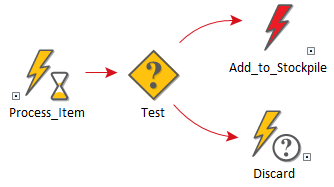Representing the Occurrence and Consequences of Discrete Events
Lesson 2, page 7 of 12
When things move through or change within a system A subunit of the world separated by a boundary from the rest of the world. The description of the system is comprised of the relations within the system as well as those characterizing the action of the outside world on the system., the dynamics can be conceptualized in two different ways: continuously or discretely. Things that move continuously can be thought of as flowing.An example of this is the movement of water.Other things move or happen discretely (e.g., such that they must be tracked individually). Examples of this include financial transactions or the movement of items through a factory.
Note, however, that just because something is considered to flow (like water), it does not mean that all of the dynamics for that system can be treated as being continuous.For example, if water is flowing from one pond to another (via a pump), and the pump suddenly breaks down, that is a "discrete event", and must be treated in an appropriate manner.
Although GoldSim is most commonly used to model dynamics that are primarily continuous, it provides powerful capabilities for representing discrete dynamics as well.In fact, most real-world systems are best described using a combination of continuous and discrete dynamics.
GoldSim provides a variety of specialized Event elements The basic building blocks with which a GoldSim model is constructed. Each element represents a feature, pararamer, process or event in the model. for simulating the occurrence and consequences of discrete events:

These elements facilitate the realistic simulation of discrete events such as financial transactions, accidents, system failures, storms, labor strikes, and lawsuits. Events such as these can have important effects on the performance of many systems, and it is therefore important to represent them in a realistic manner.